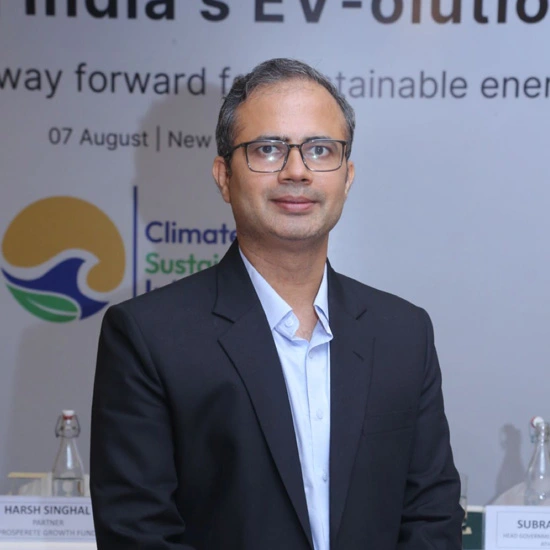This year’s Economic Survey highlighted the challenges related to supply chain vulnerabilities, the need for effective management of energy security, and the affordability of India’s energy transition. The Union Budget 2025 sought to address some of these concerns by reinforcing existing schemes and introducing new initiatives. A key focus was maintaining ministerial allocations across the electricity and automobile sectors—both central to advancing sustainability in the country.
Additionally, the Indian government announced important measures concerning critical minerals and nuclear energy, both vital for promoting growth and enhancing energy security. Support for electric vehicle (EV) adoption continues under the Ministry of Heavy Industries (MHI), with an allocation of INR 7,700 crore for FY26.
Strengthening the Electricity Sector
The Ministry of Power (MoP) and the Ministry of New and Renewable Energy (MNRE) have been allocated INR 48.4K crore for FY26, accounting for 1% of the total INR 50.6 lakh crore budget.
- Continuation of improvements in the electricity distribution
The MoP has received a net allocation of INR 21.8K crore, with INR 16K crore—about 70%—designated for the Reform-Linked Distribution Scheme. This five-year scheme, which will conclude in FY26, has a total outlay of INR 3 lakh crore and aims to reduce technical and commercial losses for distribution companies (DISCOMs).
It includes INR 97.6K crore in central government assistance, while the remainder will be managed by the states and DISCOMs. To support states in covering their expenses, the budget allows an additional 0.5% borrowing beyond the 3% FRBM limit for FY24–26, contingent on performance improvements. This measure will help financially strained states access extra resources for state-owned DISCOMs, which are essential for achieving India’s target of 500 GW of renewable energy capacity by 2030. - Public Sector Power Investments
Continuing with prior years’ infrastructure buildup push, the MoP-controlled public sector undertakings (PSUs) are projected to mobilise INR 86K crore in resources for FY26, a 21% increase from the previous year. Major contributions include INR 26K crore from NTPC and INR 25K crore from PGCIL, with additional mobilisation by government-backed hydroelectric companies.
Boosting Renewable Energy and Critical Minerals
- Expanding Distributed Solar Energy
The MNRE has received INR 26.5K crore for FY26, a 53% increase from the previous year’s revised estimates. A substantial portion—INR 20K crore—is earmarked for the PM Surya Ghar scheme, with INR 2.6K crore allocated to the KUSUM scheme. These initiatives, comprising 85% of MNRE’s budget, underscore the government’s focus on decentralised solar deployment. Meanwhile, large-scale wind, solar, and storage projects continue to attract private investments.
However, at the same time, a minuscule INR 600 crore allocation for the GH2 mission points to a small deployment of funds under the ongoing INR 19.7K crore outlay FY30 under the GH2 mission to support India’s vision to have 5 million tonnes equivalent capacity addition by 2030. - Small Modular Reactors – A Shift in India’s Energy Mix
The budget allocates INR 20K crore for the Nuclear Energy Mission, focusing on Small Modular Reactors (SMRs). This initiative aims to achieve a nuclear capacity of 100 GW by 2047—four times the current target of 20 GW for 2032. This ambitious goal reflects the government’s commitment to addressing the growing energy demands, particularly with the likely emergence of data centres and other energy-intensive applications driven by large language models and advancements in artificial intelligence. As these technologies continue to evolve, we can expect shifts in electricity production methods to meet future needs. - Securing Critical Minerals
A budget allocation of INR 400 crore for FY26 supports the establishment of the National Critical Mineral Mission (NCMM), ensuring a resilient supply chain for essential minerals. The total proposed outlay of INR 16.3K crore over seven years aligns with India’s broader strategy to secure key resources. Additionally, the Basic Customs Duty (BCD) exemption for 25 critical minerals in the budget of July 2024 and 14 other critical minerals in the budget for FY26, as well as lithium-ion battery waste and scrap, signals India’s push to develop recycling capabilities to support its storage-related industries and domestic battery manufacturing.
Sustained Support for Electric Vehicles
- Incentives for EV Growth
The Ministry of Heavy Industries (MHI), similar to the level of the past two budgets under different schemes, is expected to maintain INR 4,000 crore for demand incentive disbursals under the current PM-EDRIVE scheme for FY26. Additionally, anticipated disbursements under the PLI scheme for auto and auto components have increased, with projected claims rising to INR 2,818 crore from INR 348 crore in FY25, indicating an expected growing industry participation and allocation in FY26.
Conclusion
The budget emphasises India’s strong commitment to sustainability, energy security, and electrification. Strategic investments in renewable energy, nuclear power, critical minerals, and electric vehicles reflect significant progress in these important areas. While there are opportunities for increased support for emerging clean technologies, this budget sets a solid foundation for India’s energy transition. By addressing these areas, India can further advance its ambitious net-zero commitments and lead the way in clean energy innovation.
By Vaibhav Pratap Singh, Executive Director, Climate and Sustainability Initiative (Views are personal)

